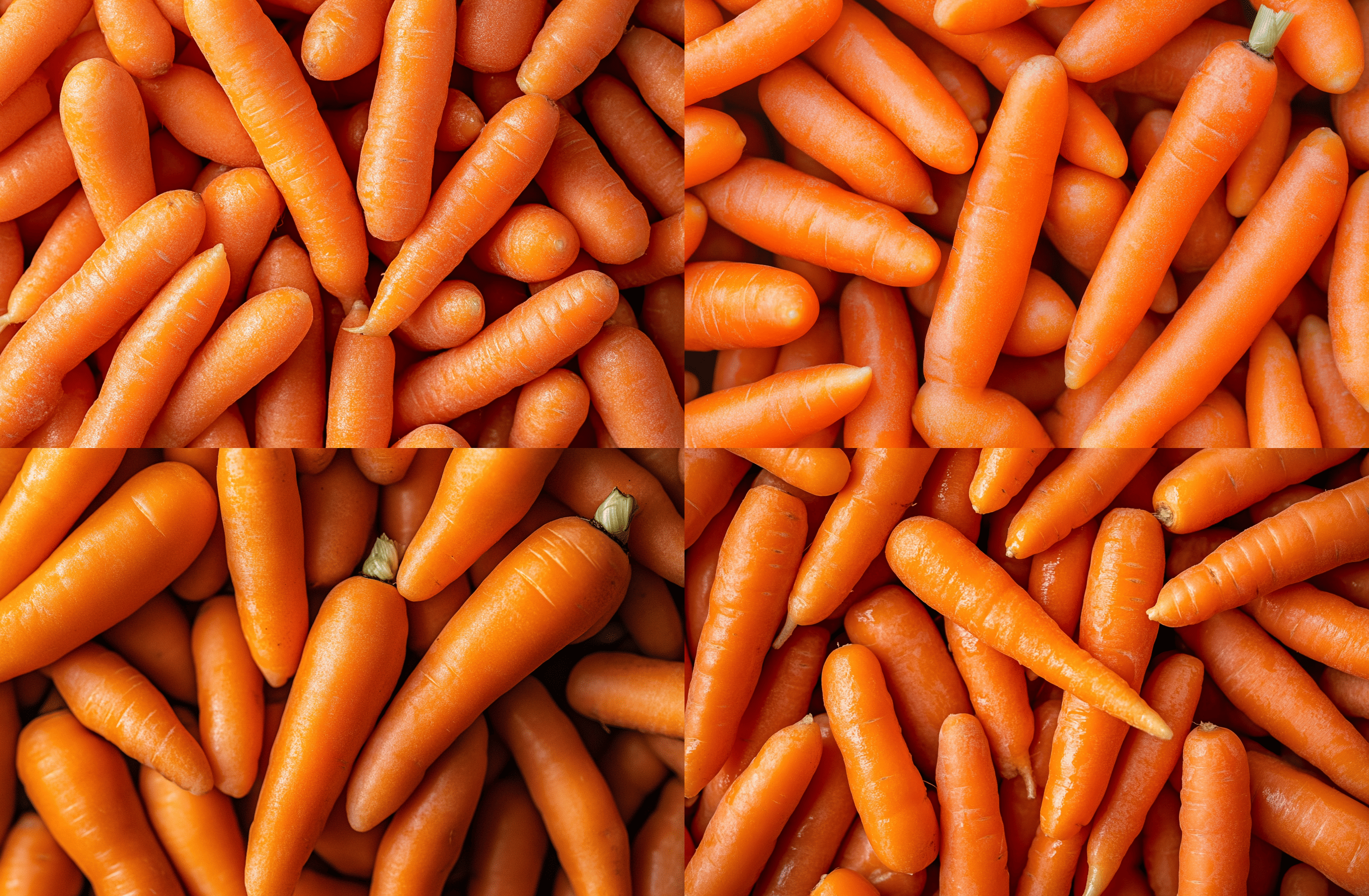Have you ever opened a bag of baby carrots and noticed a strange white coating developing after a few days? It might make you wonder if the carrots have spoiled, or if it’s a sign of mold. But don’t toss them out just yet. That whitish film isn’t rot or a harmful substance—it’s something far more ordinary and harmless.
This phenomenon is known as white blush, and it’s a perfectly natural and safe occurrence that happens to many fresh vegetables—especially carrots. Not only is it harmless, but it’s also easily reversed. Understanding what this coating is, why it forms, and how to treat it can help reduce food waste, save money, and ensure you’re not needlessly throwing away perfectly good food.
What Is “Carrot Blush”?
The white coating seen on baby carrots is commonly called “carrot blush” or “white blush.” Though the name might sound poetic, it actually refers to a simple dehydration effect that occurs when carrots lose moisture.
Carrots, especially baby carrots, have a high water content—about 86-95% water by weight. When this moisture starts to evaporate, the outer surface of the carrot becomes dry and rough. The roughness scatters light, producing a whitish appearance on the surface. This is particularly noticeable on baby carrots, which have been peeled and shaped by machine, removing their protective outer skin.
According to the USDA, white blush is caused by the drying of the outer cell layers of the carrot. The cut surfaces are especially susceptible since they’ve been shaved down to size. Baby carrots are essentially full-sized carrots that have been trimmed and shaped to make them easier to eat as a snack.
The Clemson Cooperative Extension further explains that carrots stored for extended periods in low-humidity conditions or exposed to air for long durations tend to exhibit white blush more readily. This blush is nothing more than an aesthetic issue—not a health concern.
Why Are Baby Carrots More Prone to White Blush?
You might notice that whole carrots don’t develop this white coating as often. That’s because baby carrots are more prone to dehydration due to several reasons:
-
Surface area: Baby carrots have more exposed surface area relative to their volume.
-
Mechanical processing: They’re peeled, cut, and polished—removing their natural skin, which acts as a moisture barrier.
-
Packaging: Though stored in sealed bags, frequent opening and closing exposes them to air and accelerates moisture loss.
Additionally, baby carrots are often washed in a weak chlorine solution to remove bacteria and increase shelf life. While this step is safe and widely practiced, it can also make the surface drier, contributing to white blush formation over time.
Is It Safe to Eat Baby Carrots with White Blush?
Yes—absolutely. The white coating does not indicate spoilage, mold, or bacterial growth. It simply means the carrots have lost some moisture and may be slightly less crisp than when first opened. There’s no need to worry about foodborne illness or reduced nutritional quality.
White blush is purely a cosmetic change. It does not affect the flavor, texture (in any significant way), or nutritional value of the carrots. They’re still packed with beta-carotene, fiber, vitamin K1, potassium, and antioxidants—even with that whitish haze.
If you’re ever unsure whether your carrots are safe to eat, check for these signs instead:
-
Sliminess: A slimy texture usually indicates spoilage.
-
Strong, sour odor: Fresh carrots have a mild scent. If they smell bad, discard them.
-
Mold or discoloration: Mold appears as fuzzy patches in colors like green, blue, or black. White blush is smooth and evenly spread.
-
Soft and limp texture: While this doesn’t necessarily mean they’re inedible, it might suggest they’re past their prime for raw snacking.
How to Restore Carrots That Have White Blush
You don’t need to toss out carrots with white blush. In fact, they’re very easy to revive with just a little water.
Here’s how:
-
Fill a bowl with cold water.
-
Submerge the carrots fully and let them soak for about 10 to 15 minutes.
-
Remove them and gently pat dry with a clean towel or paper towel.
The water rehydrates the outer cell layers, restoring the carrot’s original orange vibrancy and firm texture. In most cases, the white blush will disappear completely.
If some white coating remains, don’t worry—it’s still safe to eat. You can even leave them soaking in the fridge for a few hours for better results. This trick works for both baby carrots and peeled full-sized carrots.
How to Prevent White Blush
While you can’t completely eliminate the chance of white blush, you can reduce it with proper storage and handling. Here are some simple ways to keep your carrots looking and tasting fresh:
-
Store in sealed containers: Use airtight containers or resealable bags to limit air exposure.
-
Add moisture: Placing a slightly damp paper towel in the bag can help maintain humidity.
-
Keep them cold: Store carrots in the crisper drawer of your refrigerator, ideally between 32°F and 40°F (0°C to 4°C).
-
Don’t over-handle: The more you open and close the bag, the more air gets in.
-
Use quickly after opening: Try to consume within 5–7 days of opening for best appearance and texture.
Baby Carrots vs. Whole Carrots: Which Last Longer?
While baby carrots are popular for their convenience and snack-ready size, they don’t last as long as whole carrots. Whole carrots retain their outer skin, which helps trap moisture and delay dehydration.
Here’s a quick comparison:
| Type | Shelf Life (Fridge) | Prone to White Blush? |
|---|---|---|
| Whole Carrots | 2–4 weeks | Rarely |
| Baby Carrots | 1–2 weeks (once opened) | Frequently |
So, if you’re looking for a longer shelf life, consider buying whole carrots and peeling them yourself as needed. They’re also usually cheaper by weight.
Preventing Waste: Creative Ways to Use Baby Carrots
Sometimes, carrots develop white blush or become slightly soft before you get around to using them. Instead of throwing them out, repurpose them! Here are some delicious ideas for using less-than-perfect baby carrots:
-
🥕 Roast Them
Toss with olive oil, salt, pepper, and your favorite herbs. Roast at 400°F (200°C) for 20–25 minutes until caramelized and tender. -
🥣 Blend into Soup
Combine with onions, garlic, broth, and ginger for a cozy carrot soup. -
🍲 Add to Stews
Slightly limp carrots are perfect for slow-cooked dishes where texture isn’t as important. -
🧃 Juice or Smoothies
Combine with apples, ginger, and oranges for a healthy kick. -
🍰 Bake Carrot Cake or Muffins
Grated carrots add moisture and sweetness to baked goods.
The Environmental Impact of Food Waste
Every time we throw away food, we’re also wasting the resources used to grow, harvest, package, and transport it. Carrots are one of the most commonly wasted vegetables in homes. A minor imperfection like white blush shouldn’t send them to the trash.
In fact, the U.S. Department of Agriculture (USDA) estimates that 30-40% of the food supply goes to waste. By learning to recognize harmless changes like white blush, we can reduce waste and make better use of our groceries.
Fun Facts About Baby Carrots
-
Baby carrots were invented in the 1980s by a California farmer named Mike Yurosek as a way to reduce carrot waste.
-
They’re not actually “baby” in age—just full-grown carrots cut into small, snackable sizes.
-
The term “baby-cut” carrots is more accurate, but “baby carrots” stuck in the public mind.
In Summary
Next time you see that white coating on your baby carrots, don’t toss them out. That pale film isn’t mold—it’s white blush, a harmless sign that your carrots are drying out a bit. They’re still perfectly safe to eat, and a quick soak in water is all it takes to make them look fresh again.
Key Takeaways:
-
White blush is a natural dehydration effect, not spoilage.
-
Carrots with white blush are safe to eat and easy to revive.
-
Prevent white blush by storing carrots in airtight containers with moisture.
-
Use slightly worn carrots in cooked dishes to reduce food waste.
-
Baby carrots are a convenient snack and part of a healthy diet.
So the next time your carrots start looking frosty, just give them a drink—they’ll thank you with crisp, sweet crunch!

